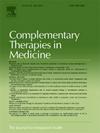Regulation of emotional states by volatile herbal extracts: Multisystem physiological evidence from Rosa rugosa, Acorus tatarinowii, and Cyperus rotundus
IF 3.5
3区 医学
Q1 INTEGRATIVE & COMPLEMENTARY MEDICINE
引用次数: 0
Abstract
Background
Traditional aromatic herbs Rosa rugosa Thunb. (R. rugosa), Acrorus tatarinowii Schott (A. tatarinowii) and Cyperus rotundus L. (C. rotundus) have been used for emotional state regulation, yet their underlying physiological mechanisms and clinical efficacy in modern applications remain underexplored.
Objective
To systematically evaluate the emotional state regulatory effects of volatile extracts from R. rugosa, A. tatarinowii, and C. rotundus through multisystem physiological measurements and develop a data-driven quantitative assessment model.
Methods
Sixty-six female participants underwent pre/post-intervention recordings of comprehensive biosignals, including 32-channel Electroencephalography (EEG), Systolic Blood Pressure (SBP), Diastolic Blood Pressure (DBP), Mean Blood Pressure (MBP), Pulse Rate (PR), Heart Rate (HR), Body Temperature (BT), Respiratory Rate (RR), and completed the Symptom Checklist-90 (SCL-90). A logistic regression model was used to integrate multisource biosignals and SCL-90 scores for constructing the emotional state scorecard.
Results
The emotional state scorecard showed 82.51 %-97.23 % classification accuracy (area under the receiver operating characteristic curve (AUC) > 0.90) across 11 emotional states. R. rugosa modulated the prefrontal-limbic network, significantly reducing somatization and hostility. A. tatarinowii influenced the limbic-autonomic interface, alleviating depression and anxiety. C. rotundus targeted the default mode network (DMN), mitigating obsessive-compulsive symptoms and depression. In depression-specific analysis, C. rotundus improved symptoms in 53.85 % of cases, while R. rugosa prevented depressive risk in 61.54 % of healthy subjects.
Conclusions
This study provides robust quantitative physiological evidence for the emotional state regulatory effects of these herbs, highlighting their translational potential in evidence-based mental health management. Future research should prioritize isolating bioactive compounds and validating efficacy via randomized controlled trials to advance precision herbal medicine.
挥发性草药提取物对情绪状态的调节:来自蔷薇、菖蒲和香蒲的多系统生理证据。
背景:传统芳香草本植物蔷薇。(R. rugosa), Acrorus tatarinowii Schott (A. tatarinowii)和Cyperus rotundus L. (C. rotundus)已被用于情绪状态调节,但其潜在的生理机制和现代应用的临床疗效尚不清楚。目的:通过多系统的生理测量,系统评价金合欢、金合欢和金合欢挥发物对情绪状态的调节作用,并建立数据驱动的定量评价模型。方法:对66名女性受试者进行32通道脑电图(EEG)、收缩压(SBP)、舒张压(DBP)、平均血压(MBP)、脉搏率(PR)、心率(HR)、体温(BT)、呼吸频率(RR)等综合生物信号记录,并填写症状量表(SCL-90)。采用logistic回归模型整合多源生物信号和SCL-90评分,构建情绪状态记分卡。结果:情绪状态记分卡对11种情绪状态的分类准确率为82.51% ~ 97.23%(受试者工作特征曲线下面积(AUC) > 0.90)。红豆杉调节前额叶边缘网络,显著减少躯体化和敌意。影响边缘-自主神经界面,减轻抑郁和焦虑。圆锥虫针对默认模式网络(DMN),减轻强迫症和抑郁症状。在抑郁症特异性分析中,圆形藤改善了53.85%的病例的症状,而绿毛藤预防了61.54%的健康受试者的抑郁风险。结论:本研究为这些草药的情绪状态调节作用提供了强有力的定量生理证据,突出了它们在循证心理健康管理中的转化潜力。未来的研究应优先分离生物活性化合物,并通过随机对照试验验证其疗效,以推进精准草药研究。
本文章由计算机程序翻译,如有差异,请以英文原文为准。
求助全文
约1分钟内获得全文
求助全文
来源期刊

Complementary therapies in medicine
医学-全科医学与补充医学
CiteScore
8.60
自引率
2.80%
发文量
101
审稿时长
112 days
期刊介绍:
Complementary Therapies in Medicine is an international, peer-reviewed journal that has considerable appeal to anyone who seeks objective and critical information on complementary therapies or who wishes to deepen their understanding of these approaches. It will be of particular interest to healthcare practitioners including family practitioners, complementary therapists, nurses, and physiotherapists; to academics including social scientists and CAM researchers; to healthcare managers; and to patients. Complementary Therapies in Medicine aims to publish valid, relevant and rigorous research and serious discussion articles with the main purpose of improving healthcare.
 求助内容:
求助内容: 应助结果提醒方式:
应助结果提醒方式:


